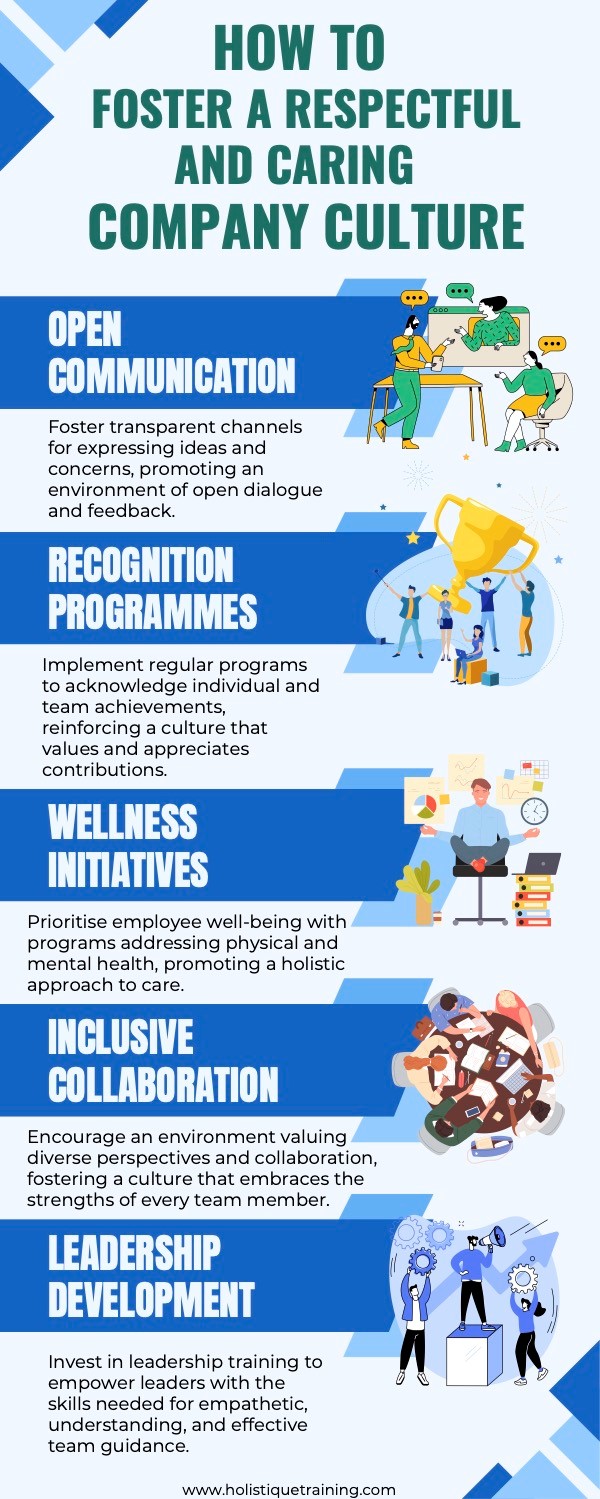- Table of Contents
- Introduction
- What Is Company Culture?
- Why Is Having a Positive Company Culture Important?
- Employee Satisfaction and Well-being
- Productivity and Performance
- Talent Attraction and Retention
- Innovation and Creativity
- Organisational Reputation
- Employee Engagement and Commitment
- Adaptability to Change
- Ethical Behaviour and Corporate Responsibility
- Customer Satisfaction
- Long-Term Organisational Success
- Statistics on Positive Company Culture
- What Does a Caring and Respectful Company Culture Look Like?
- 10 Steps to Create a Culture of Respect
- 1. Lead by Example
- 2. Establish Clear Expectations
- 3. Promote Open Communication
- 4. Recognise and Reward Respectful Behaviour
- 5. Invest in Training
- 6. Establish a Grievance Procedure
- 7. Encourage Team Building Activities
- 8. Celebrate Diversity
- 9. Provide Resources for Well-being
- 10. Regularly Assess and Adjust
- How to Foster a Caring and Respectful Culture in Remote Workplaces
- 1. Prioritise Communication Tools
- 2. Establish Virtual Team-Building Activities
- 3. Emphasise Flexibility
- 4. Provide Virtual Wellness Programmes
- 5. Encourage Regular Check-ins
- 6. Celebrate Virtual Milestones
- 7. Facilitate Virtual Mentorship Programmes
- 8. Use Technology to Foster Inclusivity
- 9. Promote Virtual Team Norms
- 10. Provide Virtual Training Opportunities
- Assessing the Effectiveness of a Respectful Culture
- 1. Employee Surveys
- 2. Key Performance Indicators (KPIs)
- 3. Leadership Feedback
- 4. Observation and Feedback Sessions
- 5. Employee Engagement Metrics
- 6. Exit Interviews
- 7. Cultural Audits
- 8. Feedback Mechanisms
- 9. Training Program Evaluations
- 10. Benchmarking Against Industry Standards
- In Conclusion
Introduction
A workplace is more than just a collection of desks and computers; it's a community of individuals striving towards common goals. The glue that binds this community together is its culture. Company culture is the invisible force shaping the attitudes, behaviours, and interactions of its members. In this journey of cultivating a thriving workplace, the essence of a culture that prioritises caring and respect cannot be overstated.
What Is Company Culture?
At its core, company culture is the set of shared values, beliefs, and behaviours that define how people within an organisation interact with each other and the world around them. It's the intangible pulse that beats beneath the surface, steering the ship through calm and stormy waters alike. A robust company culture is the foundation upon which successful teams and businesses are built.
Why Is Having a Positive Company Culture Important?
In the fast-paced world of modern business, where the focus often revolves around key performance indicators, profit margins, and market share, the significance of cultivating a positive company culture can sometimes be overlooked. However, delving deeper reveals that it is the heartbeat of an organisation, pulsating with profound implications for both individuals and the collective entity. Let's explore why having a positive company culture is not just a desirable aspect but a critical factor in achieving sustained success.
Employee Satisfaction and Well-being
A positive company culture is an elixir for employee satisfaction and well-being. When individuals feel a sense of belonging, when they believe their contributions are meaningful and appreciated, job satisfaction skyrockets. This emotional fulfilment, in turn, spills over into overall well-being, creating a work environment where individuals are not just present but fully engaged.
Productivity and Performance
The link between a positive company culture and enhanced productivity is a dynamic one. When employees are motivated by a shared set of values, when they feel supported and respected, they are more likely to invest their time and energy into their work. This heightened engagement translates into improved performance, efficiency, and, ultimately, a more robust bottom line.
Talent Attraction and Retention
In the competitive landscape of talent acquisition, a positive company culture acts as a powerful magnet. Top-tier professionals are not merely seeking employment; they are searching for an environment where their skills are valued, and their well-being is prioritised. A workplace with a positive culture becomes not just a job but a career destination, facilitating talent retention and reducing turnover costs.
Innovation and Creativity
A culture of positivity and respect fosters an atmosphere conducive to innovation and creativity. When individuals feel safe to express their ideas, take calculated risks, and collaborate without fear of ridicule, the result is a creative melting pot. It's in this nurturing environment that groundbreaking ideas are born, driving the organisation to stay ahead of the curve in a rapidly evolving business landscape.
Organisational Reputation
The reputation of a company extends far beyond its products or services. It encompasses how the company treats its employees, its ethical practices, and the overall work culture. A positive company culture becomes a beacon that attracts positive attention, not only from potential employees but also from clients, customers, and partners. This favourable reputation becomes a valuable asset in the fiercely competitive marketplace.
Employee Engagement and Commitment
Employee engagement is not just a buzzword; it's the glue that binds individuals to their work and the organisation. Positive company cultures cultivate a sense of commitment and engagement. When employees are emotionally invested in their work, they become ambassadors for the organisation, driving success through their dedication, passion, and willingness to go the extra mile.
Adaptability to Change
In today's dynamic business environment, adaptability is a key survival skill. A positive company culture, characterised by open communication and a willingness to embrace change, positions the organisation to navigate challenges with resilience. Instead of resistance, there is a collective mindset that views change as an opportunity for growth and improvement.
Ethical Behaviour and Corporate Responsibility
Positive company cultures often go hand in hand with ethical behaviour and corporate responsibility. When respect and care are embedded in the organisation's DNA, ethical considerations become integral to decision-making. This not only enhances the company's standing in the eyes of stakeholders but also contributes to the greater social good.
Customer Satisfaction
Happy employees contribute to happy customers. A positive company culture has a ripple effect on customer satisfaction. When employees feel supported and motivated, they are more likely to provide exceptional service, leading to increased customer loyalty and positive word-of-mouth marketing.
Long-Term Organisational Success
Lastly, and perhaps most importantly, a positive company culture lays the foundation for long-term organisational success. It creates a resilient framework that can weather storms, adapt to changing landscapes, and continue to evolve. It's not just about the success of today but the sustainability and growth of tomorrow.
In essence, a positive company culture is not a luxury but a strategic imperative. It is the secret sauce that transforms a group of individuals into a cohesive, high-performing team. It's an investment in the human capital that pays dividends in the form of innovation, productivity, and a workplace where both individuals and the organisation thrive. As the saying goes, "Culture eats strategy for breakfast." A positive culture not only complements strategy but often determines its success.
Statistics on Positive Company Culture
According to Team Stage, nearly half of job seekers, about 46%, consider company culture a pivotal factor when exploring employment opportunities. Furthermore, an overwhelming majority, with 94% of entrepreneurs and 88% of job seekers, underscore the indispensable role of a healthy workplace culture in achieving success. These statistics highlight the universal recognition that a positive culture is not merely a preference but a critical element in attracting talent and fostering success.
What Does a Caring and Respectful Company Culture Look Like?
In a workplace where a caring and respectful culture thrives, the atmosphere is marked by a genuine sense of openness and understanding. It transcends beyond written policies, manifesting in the daily interactions and relationships among team members. Picture a scenario where individuals are not just colleagues but collaborators, where differences are celebrated as opportunities for growth rather than sources of division.
Empathy becomes a cornerstone, creating an environment where team members are attuned to each other's needs and challenges. It's a culture where leaders take the time to understand the unique strengths and aspirations of their team, fostering an atmosphere of mutual support and respect. This sense of empathy extends not only to professional endeavours but also to the personal well-being of each individual, creating a holistic approach to care within the workplace.
Moreover, a caring and respectful culture is evident in the acknowledgment of individual contributions. Recognition becomes a natural part of the organisational fabric, with achievements, both big and small, celebrated openly. This recognition goes beyond formal awards; it permeates team meetings, emails, and daily interactions, reinforcing the idea that every team member is a valuable contributor to the shared success of the organisation. In essence, a caring and respectful company culture is not just a set of values on paper; it's a living, breathing ethos that shapes the daily experiences and interactions of everyone within the organisation.
10 Steps to Create a Culture of Respect
Building a culture of respect is a deliberate and ongoing process that involves intentional actions, consistent communication, and a commitment to fostering an environment where every team member feels valued. Here are ten actionable steps to guide your organisation in creating a culture of respect:
1. Lead by Example
Respect starts at the top. Leaders set the tone for the entire organisation. Demonstrate the values of respect in your actions, communication, and decision-making. Leaders who embody respect create a ripple effect, influencing the behaviour of the entire team.
2. Establish Clear Expectations
Clearly define the behaviours and attitudes expected from every team member. Develop a code of conduct that outlines the values of respect, inclusion, and collaboration. This clarity provides a shared understanding of the cultural norms and expectations.
3. Promote Open Communication
Create an environment where open communication is not just encouraged but celebrated. Foster a culture where team members feel comfortable expressing their thoughts, ideas, and concerns. Provide channels for feedback, whether through regular meetings, suggestion boxes, or anonymous surveys.

4. Recognise and Reward Respectful Behaviour
Actively acknowledge and reward acts of respect. This could include public recognition in team meetings, shout-outs in newsletters, or even a formal recognition program. Reinforcing respectful behaviour encourages its continuation and signals its importance within the organisation.
5. Invest in Training
Conduct regular training sessions on diversity, inclusion, and respectful communication. Equip your team with the skills needed to navigate a diverse and dynamic work environment.Training programs should go beyond compliance and focus on building a culture of understanding and empathy. You should also consider investing in leadership training, as it plays a huge role in fostering a healthy and respectful company culture. In fact,statistics show that organisations that boast best-in-class cultures exhibit a remarkable 72% higher likelihood of investing in leadership training compared to their counterparts.
6. Establish a Grievance Procedure
Create a transparent system for reporting and addressing incidents of disrespect or discrimination. Team members should feel confident that their concerns will be taken seriously and addressed promptly. Having a well-definedgrievance procedure fosters trust and accountability.
7. Encourage Team Building Activities
Foster a sense of camaraderie through team-building exercises. Team-building activities not only strengthen relationships but also create a more positive and cohesive work environment. These activities can be both formal and informal, ranging from team retreats to virtual games and collaborative projects.
8. Celebrate Diversity
Actively embrace and celebrate the diversity within your team. Recognise the unique strengths and perspectives that each individual brings to the table. Create opportunities for cultural awareness and education, ensuring that diversity is not just acknowledged but integrated into the fabric of the organisation.
9. Provide Resources for Well-being
Support the well-being of your employees by offering resources such as mental health programs, flexible work arrangements, and wellness initiatives. Demonstrating care for the holistic well-being of your team members contributes to a culture of respect and support.
10. Regularly Assess and Adjust
Company culture is not static; it evolves over time. Regularly assess the effectiveness of your efforts to build a culture of respect. Gather feedback from employees, measure key indicators, and be willing to adjust strategies based on evolving needs and challenges. Continuous improvement is key to sustaining a culture of respect.
Implementing these steps requires commitment, consistency, and a genuine belief in the importance of fostering a culture of respect. It's not just a checklist but a mindset that should permeate every level of the organisation, from leadership to entry-level employees. As the saying goes, "Respect is earned, honesty is appreciated, trust is gained, and loyalty is returned." By investing in a culture of respect, organisations create a foundation for trust, collaboration, and long-term success.
How to Foster a Caring and Respectful Culture in Remote Workplaces
The rise of remote work has presented both challenges and opportunities for cultivating a culture of caring and respect. Here are specific strategies tailored for the virtual landscape:
1. Prioritise Communication Tools
Virtual communication is the lifeline of remote teams. Invest in a variety of communication tools that facilitate seamless interaction. From video conferencing platforms to instant messaging apps, the right tools can bridge the gap and create a sense of virtual togetherness.
2. Establish Virtual Team-Building Activities
While physical distance may separate team members, virtual team-building activities can bring them closer. Organise online games, virtual happy hours, or collaborative projects that encourage camaraderie and strengthen the social bonds among team members.
3. Emphasise Flexibility
Remote work often allows for greater flexibility. According to data from Glassdoor, as cited byHR Dive, the most robust remote workplaces are found within companies that not only accommodate employees' interests but also empower them with a sense of independence. These workplaces thrive on fostering collaboration while implementing policies that embrace flexibility. Make sure you’re providing flexibility in work hours and accommodating different time zones. Encourage a results-oriented approach rather than micromanaging work hours.
4. Provide Virtual Wellness Programmes
Extend wellness programs into the virtual space. Offer virtual fitness classes, mindfulness sessions, and workshops on maintainingwell-being in a remote setting. Show your commitment to the holistic health of your remote team members.
5. Encourage Regular Check-ins
Schedule regular one-on-one check-ins between team members and managers. These sessions go beyond discussing work tasks; they provide an opportunity for open communication, addressing concerns, and ensuring that individuals feel seen and heard.
6. Celebrate Virtual Milestones
Acknowledge and celebrate achievements through virtual channels. Whether it's hitting project milestones, work anniversaries, or personal accomplishments, create virtual recognition ceremonies to celebrate and boost morale.
7. Facilitate Virtual Mentorship Programmes
Create virtual mentorship programs to foster connections and knowledge-sharing among team members. This not only promotes professional development but also contributes to a sense of community and support, even in a remote setting.
8. Use Technology to Foster Inclusivity
Leverage technology to create an inclusive virtual environment. Utilise features that allow for real-time collaboration, feedback, and participation in virtual meetings. Ensure that all team members, regardless of location, have equal access to information and opportunities.
9. Promote Virtual Team Norms
Establish clear expectations for virtual team behaviour. This could include guidelines for virtualmeeting etiquette, response times, and the use of communication channels. Clearly communicated norms help create a cohesive and respectful remote work culture.
10. Provide Virtual Training Opportunities
Offer virtual training sessions on topics relevant to remote work, such as effective virtual communication, time management, and maintaining work-life balance. Equip your remote team with the skills needed to navigate the unique challenges of working in a virtual environment.
In a remote setting, intentional efforts are required to foster a culture of care and respect. It's about transcending the limitations of physical distance and creating a virtual workspace where individuals feel connected, supported, and valued. By implementing these strategies, organisations can cultivate a thriving remote culture that promotes collaboration, well-being, and a shared sense of purpose among team members. Remember, in the world of remote work, the strength of the team is the resilience of each individual working harmoniously from their unique corner of the world.
Assessing the Effectiveness of a Respectful Culture
Building a culture of respect is an ongoing journey, and assessing its effectiveness is essential for continual improvement. Organisations can employ various strategies to gauge the impact of their efforts:
1. Employee Surveys
Conduct regular surveys to gather anonymous feedback from employees. Ask questions about their perception of the company culture, the effectiveness of implemented initiatives, and areas for improvement. Analysing survey results provides valuable insights into the prevailing sentiments within the organisation.
2. Key Performance Indicators (KPIs)
Establish KPIs related to respect and collaboration. Track metrics such as employee turnover rates, absenteeism, and project completion times. Positive trends in these areas can indicate a thriving culture where individuals feel motivated and supported.
Table 1: Key Performance Indicators (KPIs) related to respect and collaboration
KPI | Description | Measurement Method |
Employee Turnover | Evaluate turnover rates for signs of discontent | Calculate percentage of employees leaving annually |
Absenteeism | Monitor absenteeism for indicators of dissatisfaction | Track the number of unplanned employee absences |
Project Completion | Assess project completion times for efficiency | Measure the time it takes to complete key projects |
Leadership Feedback | Collect anonymous 360-degree reviews of leadership | Solicit feedback from team members on leadership effectiveness |
Employee Engagement | Use engagement tools to measure overall employee satisfaction | Analyse data on participation in events and wellness programs |
3. Leadership Feedback
Encourage open feedback about leadership. Conduct 360-degree reviews where team members can anonymously evaluate the leadership team. This not only provides insights into leadership effectiveness but also demonstrates a commitment to transparency and accountability.
4. Observation and Feedback Sessions
Regularly observe team dynamics during meetings, collaborations, and day-to-day interactions. Encourage managers to provide constructive feedback on team behaviour and communication styles. These observations offer qualitative insights into the culture's health and areas that may need attention.
5. Employee Engagement Metrics
Utilise employee engagement tools to measure the level of engagement within the organisation. High levels of engagement often correlate with a positive culture. Analyse data on participation in company events, utilisation of wellness programs, and engagement with internal communication platforms.
6. Exit Interviews
Leverage exit interviews to understand why employees leave the organisation. If there's a pattern of dissatisfaction related to the workplace culture, it's a signal that adjustments may be needed. Use this feedback to refine strategies and address any underlying issues.
7. Cultural Audits
Conduct periodic cultural audits to evaluate how well the organisation's values align with actual behaviours. Assess whether the stated values are reflected in day-to-day operations, interactions, and decision-making processes.
8. Feedback Mechanisms
Implement continuous feedback mechanisms, such as regular check-ins or suggestion boxes, to provide employees with a platform to express their thoughts. Act on this feedback, showcasing a commitment to addressing concerns and maintaining an environment of respect.
9. Training Program Evaluations
Evaluate the effectiveness of training programs focused on building a culture of respect. Measure the participation rates, gather feedback from participants, and assess whether the training has resulted in observable changes in behaviour and communication.
10. Benchmarking Against Industry Standards
Benchmark the organisation's culture against industry standards and best practices. Compare employee satisfaction scores, retention rates, and other relevant metrics to industry averages. This external perspective can provide valuable insights and identify areas for improvement.
By combining quantitative and qualitative methods, organisations can create a holistic picture of their culture's health. Regular assessments ensure that the commitment to a culture of respect remains dynamic, responsive, and aligned with the evolving needs and expectations of the workforce.
In Conclusion
Creating a culture of caring and respect is not a one-time project but an ongoing commitment. It's about fostering an environment where individuals feel valued, supported, and inspired to do their best work. By weaving these principles into the fabric of your organisation, you not only enhance the well-being of your team members but also lay the groundwork for sustained success and growth. And to guide you on this transformative journey, consider enrolling in our course, ‘Perfecting Your Management and Leadership Skills,’ where you'll gain invaluable insights and strategies to cultivate a workplace culture that thrives on care, respect, and unparalleled leadership. Elevate your skills and unlock the full potential of your team—because a thriving workplace begins with exceptional leadership. Remember, a workplace that prioritises care and respect is not just a place where people work—it's a community where they thrive.

























